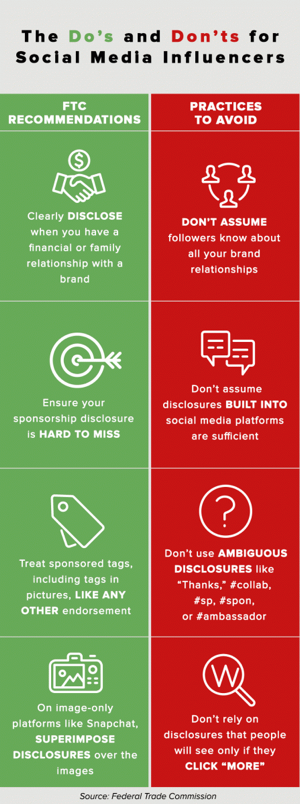A Primer: Developments in U.S. Influencer Marketing Regulations
 Influencer marketing has exploded across the U.S. in recent years, with market size increasing from $1.7 billion in 2016 to an estimated $6.5 billion in 2019. Present trends show that influencer marketing is only going to increase as people spend less time watching traditional TV and spend more time on social media.
Influencer marketing has exploded across the U.S. in recent years, with market size increasing from $1.7 billion in 2016 to an estimated $6.5 billion in 2019. Present trends show that influencer marketing is only going to increase as people spend less time watching traditional TV and spend more time on social media.
But with the rising popularity of influencer marketing comes the need to understand the rules and regulations surrounding it. Currently, influencer marketing regulations in the U.S. are still developing and the guidance that does exist is largely unenforced. But this trend may not last for long.
U.S. Influencer Marketing Oversight
In the U.S., the Federal Trade Commission (FTC) oversees influencer marketing through consumer protection and advertisement regulations. As a precursor to influencer marketing regulations, the FTC established endorsement guidelines nearly a decade ago. These guidelines require that both endorsers and advertisers clearly disclose their material connections such that the endorsement disclosure is 1) easily findable, 2) easily understandable and 3) allows the consumer to obtain sufficient information to judge the value of the endorsement. Under these guidelines both family and financial relationships must be disclosed.
In April 2017, the FTC reminded influencers and brands that these existing endorsement guidelines apply to them as endorsers/advertisers. This was followed more recently with the November 5, 2019, publication of “Disclosures 101 for Social Media Influencers”.
Past Enforcement Action
In September 2017, the FTC launched its first foray into influencer marketing enforcement. The FTC brought action against two popular YouTubers who violated endorsement guidelines by promoting through social media the gambling site CSGO Lotto without disclosing that they owned the website. Specifically, the influencers lauded how much money they were making gambling on their own site. Ultimately, the settlement only required future material disclosures of financial relationships even though the website had long shut down.
Existing and Developing Guidance for Regulatory Compliance
Alongside the 2017 enforcement action against CSGO Lotto, the FTC released expanded endorsement guidance for influencers. The expanded guidance revolved around context and content specific “clear and conspicuous disclosures” of connections between endorsers and marketers.
The guidance follows a question and answer format, oftentimes relating to specific social media outlets. For example, the FTC advises that a “clear and conspicuous disclosure” for a YouTube video would be in the video itself, not solely in the description. Similarly, Instagram posts and Tweets should have #ad near the beginning of the text. Snapchat and Instagram Stories should superimpose a disclosure over the image. Even video game streamers are advised to have a continuous, “clear and conspicuous disclosure” throughout the entire stream.
Examples from the guidance include:
- All individual content involving an ad or sponsorship should have its own “clear and conspicuous” disclosure, which is:
- Close to the claims to which they relate;
- In a font that is easy to read;
- In a shade that stands out against the background;
- For video ads, on the screen long enough to be noticed, read and understood;
- For audio disclosures, read at a cadence that is easy for consumers to follow and in words consumers will understand.
- Things to avoid
- Ambiguous disclosures like #thanks, #collab, #sp, #spon, or #ambassador
- See infographic “The Do’s and Don’ts for Social Media Influencers” (also below)
- Both brands and influencers are responsible
- FTC inquiry is based on a reasonable consumer; make sure consumers understand the disclosure
- Advertisers and brands must have programs to ensure influencer compliance with FTC guidance
- Situations that should be disclosed include any time there is:
- Receiving a product for free or being lent a product to review;
- Payment for the endorsement;
- Any (even unpaid) endorsement to a brand with which the influencer has a financial or familial relationship
 The Publication of “Disclosures 101”
The Publication of “Disclosures 101”
The “Disclosures 101” publication provides additional FTC staff “tips.” (See supporting infographic to the right.) Reinforcing its prior guidance, the FTC emphasizes the importance of staying “on the right side of the law” by urging endorses of products to make it “obvious” when there is a “material connection” to a brand. A “material connection” includes a personal, family or employment relationship or a financial relationship with a brand. Included as financial relationships meriting that disclosure are not just direct payments, but also free or discounted products or services, or more broadly, “anything of value,” which can include “perks.’
In providing this substantive guidance, the FTC staff also points out that for those involved in all the various aspects of social media, tags, likes, pins or other methods of conveying some sort of support are all considered an endorsement.
Once it is determined that there is a material connection, and there is an endorsement, then the obligation falls to the influencer to make the necessary disclosure. That disclosure should be “hard to miss,” and calculated to ensure that the viewer/reader will understand both that there has been a disclosure and what it is trying to convey. Thus, disclosures remote as to time or location are not likely to meet the disclosure requirement. Similarly, disclosures which use language that is not meaningful in the context in which they are used is also insufficient.
And, of course, deceptive or untruthful statements are not compliant. Influencers should not make up claims, or endorse things that they say are “great” or “over the top” when that is not really their view.
Future Scope of Agency Enforcement Efforts
Since the release of the expanded guidance in 2017, the FTC has not launched any major action against influencer marketing despite widespread noncompliance. To showcase noncompliance, the independent, non-profit, watchdog organization TruthInAdvertising.org (TINA.org) compiled a small database of ads that fail the FTC’s standard for disclosing material connections to the promoted brands. TINA.org has also sent letters to influencers advising compliance and filed formal complaints with the FTC. But there is no record of FTC institution of any action against influencers or brands since CSGO Lotto in 2017.
Furthermore, the lack of penalties may be a contributor to noncompliance with influencer marketing guidance. The FTC brings cases involving influencer marketing under Section 5 of the FTC Act. However, the penalties under this statute are relatively minimal such that violating the FTC endorsement guidelines can result in disgorgement of money received from violations, but there are no civil fines.
Overall, there isn’t much incentive to comply with FTC guidance. Until the FTC develops reasonable penalties and subsequently institutes action against influencers, the guidance may as well not exist.
The future of influencer marketing regulation is uncertain despite the growth of the market. But this trend may not last for long and the guidance paints a relatively clear picture of what these regulators expect. It may be best to prepare for a more heavily-regulated future. No one wants to be the first domino in an enforcement avalanche or an unlucky needle picked out of the haystack of violators.
Mark Waxman is partner and business lawyer at Foley & Lardner.




























